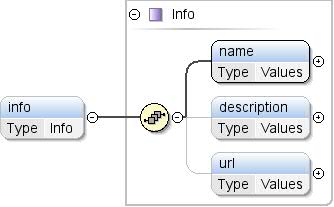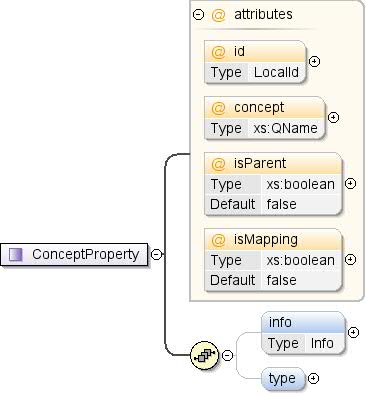Komponente: ConceptProperty
Mit Sammlungen den Überblick behalten
Sie können Inhalte basierend auf Ihren Einstellungen speichern und kategorisieren.
| Namespace |
http://schemas.google.com/dspl/2010 |
| Annotationen |
Textinformationen zum Konzeptattribut. |
| Diagramm |
 |
| Typ |
Info |
| Attribute |
| content: |
komplex |
| minOccurs (Mindestanzahl): |
0 |
|
| Modell |
name , description{0,1} , url{0,1} |
| Children |
Beschreibung, Name, url |
| Instanz |
<info>
<name>{1,1}</name>
<description>{0,1}</description>
<url>{0,1}</url>
</info>
|
| Quelle |
<xs:element name="info" type="Info" minOccurs="0">
<xs:annotation>
<xs:documentation>Textual information about the concept property.</xs:documentation>
</xs:annotation>
</xs:element>
|
| Namespace |
http://schemas.google.com/dspl/2010 |
| Annotationen |
Der Datentyp der Konzepteigenschaft. |
| Diagramm |
 |
| Attribute |
| content: |
komplex |
| minOccurs (Mindestanzahl): |
0 |
|
| Attribute |
| QName |
Typ |
Behoben |
Standard |
Verwenden |
Annotation |
| Ref. |
DataType |
|
|
erforderlich |
|
|
| Quelle |
<xs:element name="type" minOccurs="0">
<xs:annotation>
<xs:documentation>The data type of the concept property.</xs:documentation>
</xs:annotation>
<xs:complexType>
<xs:attribute name="ref" type="DataType" use="required"/>
</xs:complexType>
</xs:element>
|
Komplexer Typ: ConceptProperty
| Namespace |
http://schemas.google.com/dspl/2010 |
| Annotationen |
Eigenschaft eines Konzepts (z.B. das Land eines Konzepts)
Stadt). |
| Diagramm |
 |
| Verwendet von |
|
| Modell |
info{0,1} , Typ{0,1} |
| Children |
Info, Typ |
| Attribute |
| QName |
Typ |
Behoben |
Standard |
Verwenden |
Annotation |
| Konzept |
xs:QName |
|
|
optional |
Ein Verweis auf ein Konzept, das den Werten entspricht
der Unterkunft. Wenn die Eigenschaft einen Typ angibt,
muss mit dem Typ des referenzierten Konzepts übereinstimmen. Ein Verweis auf eine
muss das Format eines externen Konzepts
„prefix:other_concept_id“, wobei „präfix“ ist
Das für den Namespace des externen Datasets verwendete Präfix (siehe XML)
Namespaces). |
| id |
LocalId |
|
|
optional |
Die ID der Konzepteigenschaft. Diese Kennung muss
innerhalb des Konzepts (über Attribute und Eigenschaften hinweg) eindeutig sein dürfen. Die
id [ID] kann weggelassen werden, wenn die Konzepteigenschaft angegeben ist. Dabei
wird implizit eine ID mit dem lokalen Namen des
Konzept verwendet. Beispiel: <property
concept="geo:country"/> entspricht <property
id="country"
concept="geo:country"/> |
| isMapping |
xs:boolean |
|
falsch |
optional |
Bei „true“ muss diese Eigenschaft auf ein Konzept verweisen.
Diese Eigenschaft bezeichnet eine Zuordnungsbeziehung (1-zu-1) zwischen diesem
und das referenzierte Konzept verwendet. Jede Instanz des referenzierten
Konzept wird von höchstens einer Instanz dieses
Konzept. |
| isParent |
xs:boolean |
|
falsch |
optional |
Bei „true“ muss diese Eigenschaft auf ein Konzept verweisen.
Diese Eigenschaft zeigt eine hierarchische Beziehung zwischen diesem
und das referenzierte Konzept (z.B. der Kontinent eines
Land). |
|
| Quelle |
<xs:complexType name="ConceptProperty">
<xs:annotation>
<xs:documentation>A property of a concept (e.g., the country of a city).</xs:documentation>
</xs:annotation>
<xs:sequence>
<xs:element name="info" type="Info" minOccurs="0">
<xs:annotation>
<xs:documentation>Textual information about the concept property.</xs:documentation>
</xs:annotation>
</xs:element>
<xs:element name="type" minOccurs="0">
<xs:annotation>
<xs:documentation>The data type of the concept property.</xs:documentation>
</xs:annotation>
<xs:complexType>
<xs:attribute name="ref" type="DataType" use="required"/>
</xs:complexType>
</xs:element>
</xs:sequence>
<xs:attribute name="id" type="LocalId" use="optional">
<xs:annotation>
<xs:documentation>The id of the concept property. This identifier must be unique within the concept
(across attributes and properties).
The id may be omitted if the concept property is specified. In that case, an id is
implicitly created with value the local name of the referenced concept. For instance
<property concept="geo:country"/>
is equivalent to
<property id="country" concept="geo:country"/></xs:documentation>
</xs:annotation>
</xs:attribute>
<xs:attribute name="concept" type="xs:QName" use="optional">
<xs:annotation>
<xs:documentation>A reference to a concept that corresponds to the values of the property.
If the property specifies a type, then the type must match the type of the
referenced concept.
A reference to an external concept must be of the form "prefix:other_concept_id",
where "prefix" is the prefix used for the namespace of the external dataset
(see XML namespaces).</xs:documentation>
</xs:annotation>
</xs:attribute>
<xs:attribute name="isParent" type="xs:boolean" use="optional" default="false">
<xs:annotation>
<xs:documentation>If true, then this property must reference a
concept, and this property denotes a hierarchical
relationship between this concept and the referenced
concept (e.g., the continent of a country).</xs:documentation>
</xs:annotation>
</xs:attribute>
<xs:attribute name="isMapping" type="xs:boolean" use="optional" default="false">
<xs:annotation>
<xs:documentation>If true, then this property must reference a
concept, and this property denotes a mapping
(1-to-1) relationship between this concept and the
referenced concept. Each instance of the referenced
concept is referenced by at most one instance of
this concept.</xs:documentation>
</xs:annotation>
</xs:attribute>
</xs:complexType>
|
| Namespace |
Kein Namespace |
| Typ |
DataType |
| Attribute |
| verwenden Sie zum Beispiel: |
erforderlich |
|
| Attribute |
| Aufzählung |
String |
|
| Aufzählung |
float |
|
| Aufzählung |
Ganzzahl |
|
| Aufzählung |
boolean |
|
| Aufzählung |
Datum |
|
| Aufzählung |
Konzept |
|
|
| Verwendet von |
|
| Quelle |
<xs:attribute name="ref" type="DataType" use="required"/>
|
| Namespace |
Kein Namespace |
| Annotationen |
Die ID der Konzepteigenschaft. Diese Kennung muss eindeutig sein
innerhalb des Konzepts (über Attribute und Eigenschaften) hinweg. Die ID kann lauten:
ausgelassen, wenn die Konzepteigenschaft angegeben ist. In diesem Fall ist eine ID
implizit mit dem lokalen Namen des referenzierten Konzepts erstellt wird.
Beispiel: <property concept="geo:country"/> ist
entspricht <property id="country"
concept="geo:country"/> |
| Typ |
LocalId |
| Attribute |
| verwenden Sie zum Beispiel: |
optional |
|
| Attribute |
|
| Verwendet von |
|
| Quelle |
<xs:attribute name="id" type="LocalId" use="optional">
<xs:annotation>
<xs:documentation>The id of the concept property. This identifier must be unique within the concept
(across attributes and properties).
The id may be omitted if the concept property is specified. In that case, an id is
implicitly created with value the local name of the referenced concept. For instance
<property concept="geo:country"/>
is equivalent to
<property id="country" concept="geo:country"/></xs:documentation>
</xs:annotation>
</xs:attribute>
|
| Namespace |
Kein Namespace |
| Annotationen |
Ein Verweis auf ein Konzept, das den Werten der
Property. Wenn die Eigenschaft einen Typ angibt, muss dieser mit dem
Typ des referenzierten Konzepts. Ein Verweis auf ein externes Konzept muss
Format "prefix:other_concept_id", wobei
„Präfix“ ist das Präfix, das für den Namespace des externen
(siehe XML-Namespaces). |
| Typ |
xs:QName |
| Attribute |
| verwenden Sie zum Beispiel: |
optional |
|
| Verwendet von |
|
| Quelle |
<xs:attribute name="concept" type="xs:QName" use="optional">
<xs:annotation>
<xs:documentation>A reference to a concept that corresponds to the values of the property.
If the property specifies a type, then the type must match the type of the
referenced concept.
A reference to an external concept must be of the form "prefix:other_concept_id",
where "prefix" is the prefix used for the namespace of the external dataset
(see XML namespaces).</xs:documentation>
</xs:annotation>
</xs:attribute>
|
| Namespace |
Kein Namespace |
| Annotationen |
Bei „true“ muss diese Eigenschaft auf ein Konzept verweisen.
bezeichnet eine hierarchische Beziehung zwischen diesem Konzept und der
Referenzkonzept (z.B. Kontinent eines Landes). |
| Typ |
xs:boolean |
| Attribute |
| verwenden Sie zum Beispiel: |
optional |
| default: |
falsch |
|
| Verwendet von |
|
| Quelle |
<xs:attribute name="isParent" type="xs:boolean" use="optional" default="false">
<xs:annotation>
<xs:documentation>If true, then this property must reference a
concept, and this property denotes a hierarchical
relationship between this concept and the referenced
concept (e.g., the continent of a country).</xs:documentation>
</xs:annotation>
</xs:attribute>
|
| Namespace |
Kein Namespace |
| Annotationen |
Bei „true“ muss diese Eigenschaft auf ein Konzept verweisen.
bezeichnet eine Zuordnungsbeziehung (1-zu-1) zwischen diesem Konzept und
Konzept verwendet. Jede Instanz des referenzierten Konzepts
von höchstens einer Instanz dieses Konzepts referenziert wird. |
| Typ |
xs:boolean |
| Attribute |
| verwenden Sie zum Beispiel: |
optional |
| default: |
falsch |
|
| Verwendet von |
|
| Quelle |
<xs:attribute name="isMapping" type="xs:boolean" use="optional" default="false">
<xs:annotation>
<xs:documentation>If true, then this property must reference a
concept, and this property denotes a mapping
(1-to-1) relationship between this concept and the
referenced concept. Each instance of the referenced
concept is referenced by at most one instance of
this concept.</xs:documentation>
</xs:annotation>
</xs:attribute>
|
Erstellt mit dem
oXygen XML Editor
Sofern nicht anders angegeben, sind die Inhalte dieser Seite unter der Creative Commons Attribution 4.0 License und Codebeispiele unter der Apache 2.0 License lizenziert. Weitere Informationen finden Sie in den Websiterichtlinien von Google Developers. Java ist eine eingetragene Marke von Oracle und/oder seinen Partnern.
Zuletzt aktualisiert: 2025-07-25 (UTC).
[[["Leicht verständlich","easyToUnderstand","thumb-up"],["Mein Problem wurde gelöst","solvedMyProblem","thumb-up"],["Sonstiges","otherUp","thumb-up"]],[["Benötigte Informationen nicht gefunden","missingTheInformationINeed","thumb-down"],["Zu umständlich/zu viele Schritte","tooComplicatedTooManySteps","thumb-down"],["Nicht mehr aktuell","outOfDate","thumb-down"],["Problem mit der Übersetzung","translationIssue","thumb-down"],["Problem mit Beispielen/Code","samplesCodeIssue","thumb-down"],["Sonstiges","otherDown","thumb-down"]],["Zuletzt aktualisiert: 2025-07-25 (UTC)."],[],["ConceptProperty defines a characteristic of a concept, with optional `info` and `type`. The `info` contains text about the property, including `name`, `description`, and `url`. `type` specifies the data type. Attributes include an optional `id` for unique identification, an optional `concept` to reference related concepts, `isParent` (hierarchical relationship), and `isMapping` (1-to-1 relationship), both booleans, defaulting to `false`. The `@ref` attribute is required for type and defines the data type of the referenced concept.\n"]]



